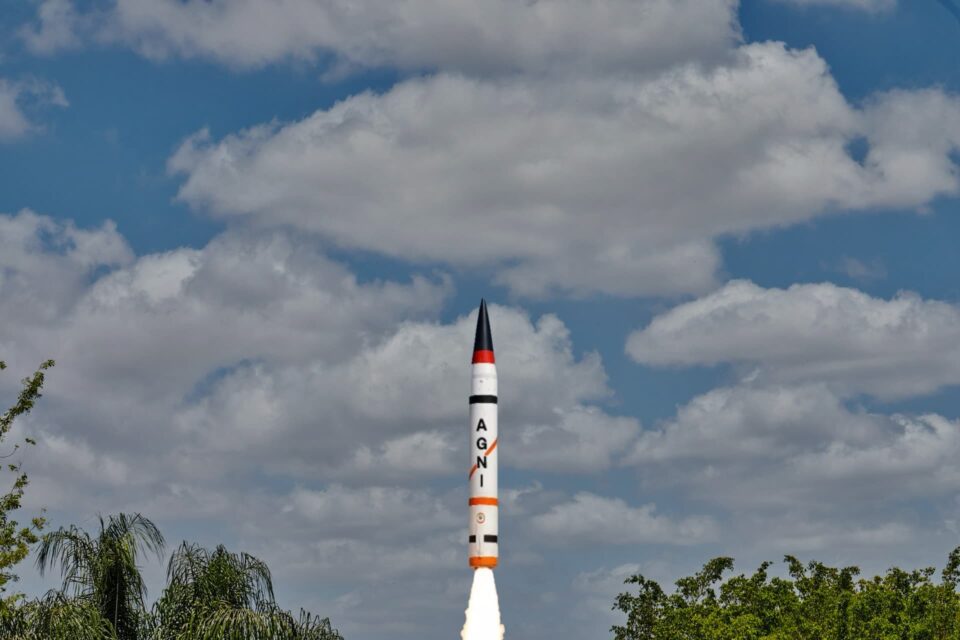On August 20, 2025, the morning sky over the Odisha coast blazed with the light of a mission unprecedented in Indian history as the mother of all missiles, Agni-5, rip-roared off the island launch pad at the Integrated Test Range (ITR), Chandipur. In a matter of minutes, the successful test revalidated India’s membership in a small group of nations that can deliver long-range precision strikes.
This wasn’t just a test. It was a blaringly clear message: India’s defense capabilities are modern, dependable, and prepared to secure the country’s interests in an uncertain world.
What Makes Agni-5 Special?
- Range: Over 5,000 km, covering almost all of Asia and parts of Europe.
- Nuclear-Capable: Strengthens India’s nuclear triad with credible second-strike ability.
- Accuracy: Equipped with advanced navigation and guidance systems.
- Maneuverable Re-entry Vehicle: Can outsmart enemy defense systems.
- Future Upgrades: Expected to feature MIRV technology, allowing one missile to carry multiple independently targetable warheads.
In simple terms, Agni-5 gives India the ability to hit far, hit hard, and hit precisely.
Why This Test Matters
The successful Agni-5 flight-test arrives when geopolitical tides are moving decisively. With a range surpassing four thousand kilometers, this missile serves a dual function: it is a shield for the nation and a calculated brake on adversary calculations. The trajectory and post-boost maneuvers project an unmistakable signal: any hostile designs that might be contemplated across the region will confront a well-prepared reprisal. India’s calibrated decision, enshrined in the No First Use doctrine, signals the absence of malicious intent; the bomb is reserved as final refuge, never as the confident sword of initiation. The Agni-5, therefore, amplifies the vow of controlled potency, offering partners quiet assurance while quietly counseling adversaries that the boundaries, if breached, incur painful consequences.
Boost to India’s Strategic Confidence
The Strategic Forces Command oversaw the evaluation, confirming both the technical envelope of the missile and the defence organisation’s field readiness. Every positive iteration reduces the runway towards absolute domestic mastery of high-end missile systems, a capability once reserved in discourse for the most established world powers.
Parallel assessments of the Prithvi-II and Agni-I underscore the entire Indian arsenal’s cohesion – from tactical theatres to intended intercontinental reach – showing incremental confidence in trajectories, propulsion, and terminal accuracies.
The Geopolitical Angle
Whenever India tests a missile of this scale, the world takes notice.
- China: With the Agni-5 now confirming that the bulk of Chinese territory lies within its reach, observers in Beijing will almost certainly tighten surveillance of India’s evolving missile inventory. Today’s event firmly establishes New Delhi’s footprint in the region and underscores the widening spectrum of its defensive capacity.
- Pakistan: Though the Agni-5 cannot yet reach most of Pakistani territory, its deployment nonetheless redresses the regional balance, intensifying Islamabad’s strategic calculus and showcasing India’s expanding power projection capabilities.
- Global Community: Washington, Moscow, and Paris continue to affirm India’s missile advancements as a legitimate component of national security. Viewed through the lens of collective stability, this endorsement positions New Delhi as an increasingly influential and responsible stakeholder in the international security architecture.
What’s Next?
Agni-5 appears to have an even brighter future:
- Extended Range: Future iterations might have a 7,500-kilometer range.
- MIRV Technology: A missile with multiple warheads would be much more deadly.
- Enhancing strike options against fortified targets is possible with bunker-busting capabilities.
- With every upgrade, India is securing its strategic independence and fortifying its defences against changing threats.
Quick Snapshot: Agni-5 at a Glance
| Feature | Detail |
| Type | Intermediate-Range Ballistic Missile (IRBM) |
| Range | 5,000+ km (future: up to 7,500 km) |
| Payload | Nuclear-capable, potential for MIRV |
| Launched From | Integrated Test Range, Chandipur, Odisha |
| Supervised By | Strategic Forces Command |
| Significance | Strengthens nuclear deterrence and strategic autonomy |
Conclusion: A Missile, A Message
India’s latest Agni-5 launch is more than a textbook display of missile science; it is a deliberate statement of resolved national autonomy. Entirely conceived and manufactured in India, Agni-5 crystallizes an imperative choice: to harness homegrown ingenuity as the first and primary shield for national well-being. With this vehicle, the country projects steadfast purpose, emphasizing that a commitment to dialogue exists alongside an equally strong resolve to defend. The test widens the bandwidth of India’s international agency, combining measured diplomacy with the unmistakable clarity of assured deterrence. In this calibrated posture, Agni-5 affirms a triple pledge: safeguarding the present, preserving sovereignty, and securing the future.
Frequently Asked Questions (FAQs)
Why is Agni-5 important for India?
Agni-5 strengthens India’s nuclear deterrence and ensures credible second-strike capability. With its long range and accuracy, it helps India secure its sovereignty and maintain peace in the region.
What is the range of Agni-5?
The missile has a range of over 5,000 km, covering large parts of Asia, including northern China, and extending to parts of Europe. Future upgrades may increase its range to 7,500 km.
Is Agni-5 nuclear-capable?
Yes, Agni-5 is nuclear-capable and designed to carry both conventional and nuclear warheads, making it a critical part of India’s defense strategy.
Which countries are within Agni-5’s range?
With its 5,000+ km strike range, Agni-5 can reach almost all of Asia, including China and Pakistan, and parts of Europe, giving India strong strategic reach.
Is Agni-5 an intercontinental ballistic missile (ICBM)?
Technically, Agni-5 is classified as an Intermediate-Range Ballistic Missile (IRBM) since its range is just above 5,000 km. However, with future upgrades, it could enter the lower spectrum of ICBM capabilities.
How does Agni-5 contribute to India’s defence policy?
Agni-5 supports India’s “No First Use” nuclear policy by ensuring that the country has a reliable second-strike capability. This strengthens deterrence and discourages potential aggression.

